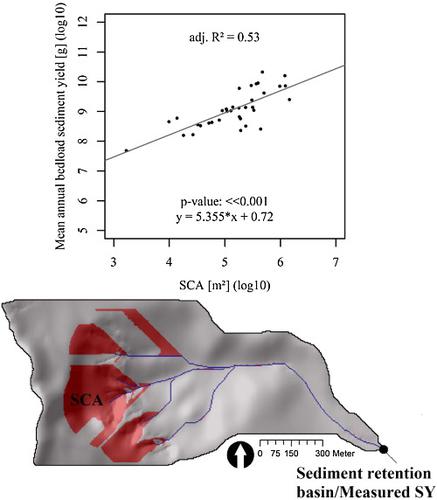当前位置:
X-MOL 学术
›
Earth Surf.Process. Land.
›
论文详情
Our official English website, www.x-mol.net, welcomes your
feedback! (Note: you will need to create a separate account there.)
Modelling of sediment supply from torrent catchments in the Western Alps using the sediment contributing area (SCA) approach
Earth Surface Processes and Landforms ( IF 2.8 ) Pub Date : 2020-12-08 , DOI: 10.1002/esp.5046 Moritz Altmann 1 , Florian Haas 1 , Tobias Heckmann 1 , Frédéric Liébault 2 , Michael Becht 1
Earth Surface Processes and Landforms ( IF 2.8 ) Pub Date : 2020-12-08 , DOI: 10.1002/esp.5046 Moritz Altmann 1 , Florian Haas 1 , Tobias Heckmann 1 , Frédéric Liébault 2 , Michael Becht 1
Affiliation

|
The production of coarse sediment in mountain landscapes depends mainly on the type and activity of geomorphic processes and topographic and natural conditions (e.g. vegetation cover) of these catchments. The supply of sediment from these slopes to mountain streams and its subsequent transport lead to sediment connectivity, which describes the integrated coupled state of these systems. Studies from the Northern Calcareous Alps show that the size of the sediment contributing area (SCA), a subset of the drainage area that effectively delivers sediment to the channel network, can be used as a predictor of sediment delivery to mountain streams. The SCA concept is delineated on a digital elevation model (DEM) using a set of rules related to the steepness and length of slopes directly adjacent to the channel network, the gradient of the latter and the vegetation cover. The present study investigates the applicability of this concept to the Western Alps to identify geomorphologically active areas and to estimate mean annual sediment yield (SY) in mainly debris‐flow‐prone catchments. We use a statistical approach that shows a parameter optimisation and a linear regression of SY on SCA extent. We use a dataset of ~25 years of assessed coarse sediment accumulation in 35 sediment retention basins. In the investigated catchments, sediment transport is governed by several factors, mainly by the extent of vegetation‐free areas with a minimum slope of 23° that is coupled to the channel network with a very low gradient of the latter. With our improved framework, we can show that the SCA approach can be applied to catchments that are widely distributed, in a large spatial scale (hectare area) and very heterogeneous in their properties. In general, the investigated catchments show high connectivity, resulting in significant correlations between long‐term average yield and the size of the SCA.
中文翻译:

使用沉积物贡献区(SCA)方法对西阿尔卑斯山洪流集水区的泥沙供应进行建模
山区景观中粗粒沉积物的产生主要取决于地貌过程的类型和活动以及这些集水区的地形和自然条件(例如植被覆盖度)。这些斜坡向山streams的泥沙供应及其随后的运输导致泥沙连通性,这描述了这些系统的综合耦合状态。北部钙质阿尔卑斯山的研究表明,沉积物贡献区(SCA)的大小是有效将沉积物输送到河道网络的流域的一个子集,可以用作预测泥沙输送到山区河流的指标。SCA概念是在数字高程模型(DEM)上使用一组与通道网络直接相邻的斜坡的陡度和长度有关的规则来描述的,后者和植被覆盖的梯度。本研究调查了该概念在西阿尔卑斯山的适用性,以识别地貌活跃区域并估计主要是泥石流多发流域的年平均沉积物产量(SY)。我们使用统计方法来显示SCA范围内的参数优化和SY的线性回归。我们使用约25年的数据集评估了35个沉积保留盆地中的粗沙沉积。在所调查的流域中,泥沙的输送受多种因素控制,主要是由最小植被坡度最小为23°的无植被区域的范围决定的,而该区域以非常低的坡度耦合到河床网络。通过改进的框架,我们可以证明SCA方法可以应用于分布广泛的集水区,在较大的空间范围(公顷)内,其特性非常不同。通常,所调查的流域显示出高度的连通性,从而导致长期平均产量与SCA大小之间存在显着的相关性。
更新日期:2020-12-08
中文翻译:

使用沉积物贡献区(SCA)方法对西阿尔卑斯山洪流集水区的泥沙供应进行建模
山区景观中粗粒沉积物的产生主要取决于地貌过程的类型和活动以及这些集水区的地形和自然条件(例如植被覆盖度)。这些斜坡向山streams的泥沙供应及其随后的运输导致泥沙连通性,这描述了这些系统的综合耦合状态。北部钙质阿尔卑斯山的研究表明,沉积物贡献区(SCA)的大小是有效将沉积物输送到河道网络的流域的一个子集,可以用作预测泥沙输送到山区河流的指标。SCA概念是在数字高程模型(DEM)上使用一组与通道网络直接相邻的斜坡的陡度和长度有关的规则来描述的,后者和植被覆盖的梯度。本研究调查了该概念在西阿尔卑斯山的适用性,以识别地貌活跃区域并估计主要是泥石流多发流域的年平均沉积物产量(SY)。我们使用统计方法来显示SCA范围内的参数优化和SY的线性回归。我们使用约25年的数据集评估了35个沉积保留盆地中的粗沙沉积。在所调查的流域中,泥沙的输送受多种因素控制,主要是由最小植被坡度最小为23°的无植被区域的范围决定的,而该区域以非常低的坡度耦合到河床网络。通过改进的框架,我们可以证明SCA方法可以应用于分布广泛的集水区,在较大的空间范围(公顷)内,其特性非常不同。通常,所调查的流域显示出高度的连通性,从而导致长期平均产量与SCA大小之间存在显着的相关性。











































 京公网安备 11010802027423号
京公网安备 11010802027423号